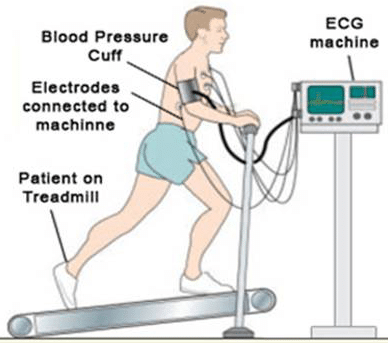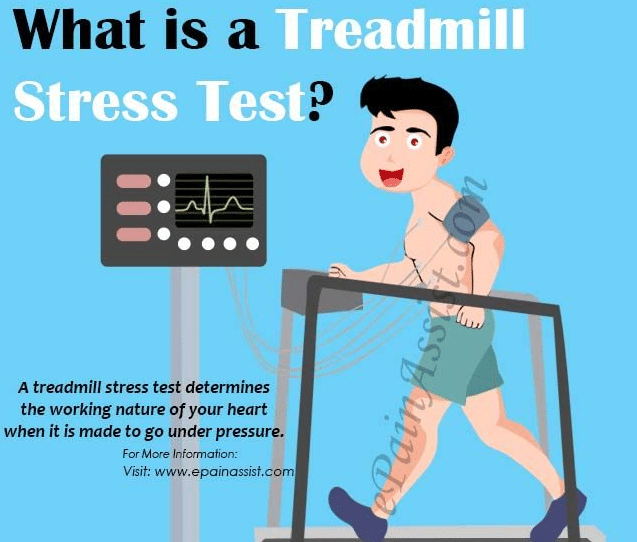Nuclear Stress Test: A nuclear stress test is a study aimed at measuring whether the blood flow to your heart muscle is normal or abnormal. The study utilizes a radioactive tracer to create an image of how well blood is reaching your heart muscle, both during exercise and while at rest. If you are unable to exercise, or your doctor thinks exercise is not a good idea for you, this study can still be performed by giving you a medication that produces the same kind of cardiovascular stress that is caused by exercise.
The nuclear nervousness test is most often used to estimate the severity of any blockages that might be present due to coronary artery malady.1 This study is generally understood to be the most meticulous non-invasive method for diagnosing coronary artery stoppages. In many cases, doing a nuclear nervousness test can make it unnecessary to perform an invasive cardiac catheterization.

What Is A Nuclear Stress Test
A nuclear weight test uses radioactive dye and an imaging instrument to create pictures showing the juice flow to your heart. The test measures blood flow while you are at rest and are expending yourself, showing areas with underprivileged blood flow or damage in your character. The test usually involves injecting contaminate dye, then taking two sets of images of your character — one while you’re at rest and another after exertion.
A nuclear stress test is one of several types of stress tests that may be performed alone or in combination. Compared with an exercise stress test, a nuclear stress test can help better determine your risk of a heart attack or other cardiac event if your doctor knows or suspects that you have coronary artery disease.
You may need a nuclear stress test if an unremarkable stress test didn’t diagnose the cause of manifestations such as chest pain or shortness of breath. A nuclear stress test may also be used to guide your medication if you’ve been investigating with a heart status. Your doctor may advocate a nuclear stress test to:
- Diagnose coronary artery disease. Your coronary arteries are the major blood vessels that supply your heart with blood, oxygen, and nutrients. Coronary artery disease develops when these arteries become damaged or diseased — usually due to a buildup of deposits containing cholesterol and other substances (plaques). If you have symptoms such as chest pain or shortness of breath, a nuclear stress test can help determine if you have coronary artery disease and how severe the condition is.
- Guide treatment of heart disorders. If you’ve been diagnosed with coronary artery disease, a nuclear stress test can help your doctor find out how well treatment is working. It may also be used to help establish the right treatment plan for you by determining how much exercise your heart can handle.
Precautions After Nuclear Stress Test

In the nuclear stress test with exercise, a radionuclide, such as thallium or technetium, is injected into a vein in the hand or arm.
When the radionuclide has circulated through the bloodstream, a gamma camera takes pictures of the heart while the patient is lying down. This is known as the “rest scan” of the heart.
The patient then moves onto a treadmill. The treadmill starts slowly and gradually picks up speed and incline, to simulate walking or running uphill.
At peak exercise, more radionuclide is injected into the patient. When the radionuclide has passed through the bloodstream, the gamma camera takes more pictures of the heart. This is known as the “stress scan” of the heart.
The radionuclide helps to identify blocked or partially blocked arteries on the scans because blocked arteries do not absorb the radionuclide into the heart. They are known as “cold spots.”
The nuclear stress test can help to diagnose a heart condition by giving vital information.
This data includes:
- the size of the heart chambers
- how well the heart is pumping blood
- whether there is any damage to the heart
- if there is any blockage or narrowing of the coronary arteries that provide blood to the heart
- the effectiveness of any current treatment.
The test can also help determine whether the patient is suitable for a cardiac rehabilitation program, and if so, how hard they should exercise.
Nuclear Stress Test Cost
A nuclear stress test is generally safe, and complications are rare. As with any medical procedure, there is a risk of complications, including:
- Allergic reaction. Though rare, you could be allergic to the radioactive dye that’s injected during a nuclear stress test.
- Abnormal heart rhythms (arrhythmias). Arrhythmias brought on during a stress test usually go away shortly after you stop exercising or the medication wears off. Life-threatening arrhythmias are rare.
- Heart attack (myocardial infarction). Although extremely rare, it’s possible that a nuclear stress test could cause a heart attack.
- Dizziness or chest pain. These symptoms can occur during a stress test. Other possible signs and symptoms include nausea, shakiness, headache, flushing, shortness of breath and anxiety. These signs and symptoms are usually mild and brief, but tell your doctor if they occur.
- Low blood pressure. Blood pressure may drop during or immediately after exercise, possibly causing you to feel dizzy or faint. The problem should go away after you stop exercising.
Nuclear Stress Test Side Effects
In people who are already known to have coronary artery disease, the nuclear stress test is often also quite helpful in developing an optimal treatment plan.
People who are being treated for coronary artery disease, whether with medication or a stent, will often have nuclear stress testing both to help judge the effectiveness of the therapy, and to get the information needed to provide objective advice about daily activities and exercise.
The idea of nuclear stress testing is to create two images of how blood is being distributed to the cardiac muscle—one during rest, and one during exercise. Normally, the blood should be evenly distributed to the heart muscle both at rest and while exercising, and the images will show this even distribution.
If both the rest and the exercise images show a fixed patch of poor blood flow, that indicates that a prior heart attack has occurred. If an area of poor blood flow is identified during stress testing that is not present during rest, that indicates that a blockage is likely in one of the coronary arteries that is producing a transient drop in blood flow.
So this test enables the doctor to detect the presence, location, and relative size of a prior heart attack; and the presence, location, and relative size of any blockages in the coronary arteries that are significant enough to impede blood flow during exercise.
Does a nuclear stress test show block arteries?
The test can show the size of the heart’s chambers, how well the heart is pumping blood, and whether the heart has any damaged or dead muscle. Nuclear stress tests can also give doctors information about your arteries and whether they might be narrowed or blocked because of coronary artery disease.


